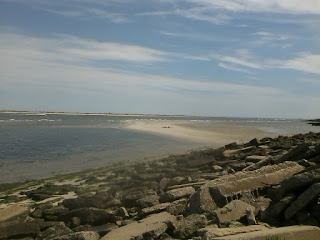So why am I beginning this post with a photo of a house in France most Americans have never seen?
Well, if you've been reading this blog long enough, you know that I'm a bit of a Francophile. Yes, just a little bit. One way you know that I'm American is that I am also something of an Anglophile and see no contradiction!
Anyway, the house is in a French city most foreigners (except, perhaps, from neighboring countries) never visit. That's a shame, really, because it reveals so much about France that people don't experience during the three or four das they spend in Paris as part of their European trips.
You can probably guess one reason I included the photo: I have cycled to that house. And to this one:
Now, that's one tourists are more likely to see. It's in Paris, on one of the city's most elegant squares, the Place des Vosges. There's a nice little park in the middle of the square where Parisians take lunch breaks or walk their dogs or kids, or just loll around on the grass. And folks like me ride or walk there, baguette and hunk of cheese in hand.
One great thing about the Place des Vosges is that it's next to one of the most historic parts of Paris--le Marais--and literally steps from all sorts of interesting museums, galleries and shops.
Anyway, the house in Besancon and the one in Paris share something: specifically, someone who lived in them.
I'll give you a hint: He wrote the novel more people know about without actually having read. In the English-speaking world that has much to do with a musical--a musical!--made out of that novel. You may have seen it.
That novel is, of course, Les Miserables, written by none other than Victor Hugo.
Just as more people know about Les Miserables than any other novel without having read it, more people lie about having read Moby Dick than any other novel. Now I'm going to tell you a secret: If you're ever at a dinner party with a bunch of snotty pseudo-intellectuals, you can more or less bluff your way through a discussion of MD if you've read Old Man and the Sea!
But I digress. No, it's not really a digression: It's part of what I'm going to say, just like all of those hundred-page long asides about the Paris sewer system or whaling in New England are integral to LM and MD, respectively.
You see, such seeming digressions are part of some of the best bike rides. You might start with a destination in mind or that you are simply going to ride a certain distance or amount of time. Unless you're riding strictly for training purposes, the parts of the ride you'll remember are the things you encountered along the way.
In the case of Besancon, I found myself there because of a challenge. In the summer of 1997, I bought a round-trip ticket to Paris--with a return date of a month after my departure--and brought my bicycle, among other things. I had no particular plan except to visit my friends in Paris and get on my bike. In those days, I used to take trips like that, staying in hostels or pensiones--or simply rolling out my sleeping bag--wherever I found myself when I stopped riding for the day.
I was talking to Jay and Isabelle, whom I've mentioned in other posts, when Isabelle asked, "Ou n'avais pas visite en France?" As I tried to think of some place in France where I hadn't been, Jay blurted "Alpes"!
"Les Alpes?" Even though I understood perfectly well, I just had to make sure.
They both nodded. So did I.
And so I pedaled south and east from Paris. That is how I found myself, five days later (spending days in Troyes and Chaumont) in Besancon, on the edge of the Jura mountains, which are a kind of sub-range of the Alps. A few days after that I was in Chamonix and hiked up part of Mont Blanc.
Anyway, Victor Hugo was born in the house in Besancon. That house, amazingly enough, is in a square that also contains the houses in which painter Gustave Courbet, writer Charles Nodier and the Lumiere brothers--considered the "fathers" of cinema--were born!
And, of course, I've cycled (and walked) to the Hugo house on Place des Vosges any number of times during my stays in Paris.
So why am I thinking about Victor Hugo now? Turns out, on this date in 1862, he completed Les Miserables. It was published soon after and became popular with soldiers on both sides of the US Civil War. "I've been reading Hugo's account of Waterloo in Les Miserables and preparing my mind for something of the same sort," wrote Wilky James of the Massachusetts Free Black Regiment in 1863. "God grant the battle may do as much harm to the rebels as Waterloo did to the French."
The funny thing is that the sections about Waterloo--and the Paris sewer system--are what got the novel both praised and lambasted. But Les Miserables could no more exist without them than Moby Dick could without al the stuff about New England whaling practices--or our favorite ride without whatever you encountered along the way.





























